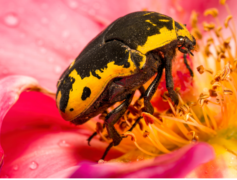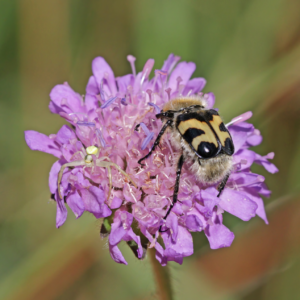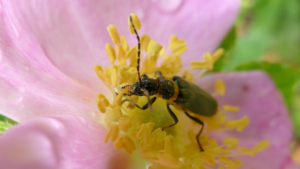
A Little-Known Group of Pollinators: Beetles!
Thanks to the University of Maryland/Maryland Grows this informative article on beetle pollinators.
As we mentioned in previous posts, when we think about pollinators, we tend to think of butterflies and bees. However, we rarely consider the super-important hoverflies or other groups of organisms. In today’s post, I want to tell you about another of those little-known pollinator groups. Let’s talk about beetles that act as pollinators!
Beetles: “hard-shelled” pollinators
From a taxonomic perspective, beetles are a group of insects that belong to the Order Coleoptera. Among other important characteristics, they are recognized by their extremely well-protected body, in particular by structures called “elytra.” This provides a very hard cover to their wings (the wings are placed under the elytra). Generally, beetles have mouth parts that are adapted to chewing, which means that they have large mandibles that allow them to break their food. You may be wondering why I am talking about these structures in a pollination post. Well, as for all pollinators, the shape and function of a pollinator define what they do (and don’t do). Let’s see how this affects our pollinating beetles.

Beetles in the yard
In the case of beetles, the fact that they are well protected by those elytra makes them more “confident.” That “hard shell” provides a great deal of protection against predation by other arthropods, which in turn makes them generally more “chill” in their visits to flowers. Unlike butterflies, bees, or hoverflies, beetles tend to move little within and between flowers. Instead, they take all their time to get the resources they need from them. For this reason, they are often considered more generalist and inconsistent pollinators than their less-protected counterparts.
The shape of their mouths and their feeding habits also affect their efficiency as pollinators. In fact, beetle visits to flowers tend to be relatively destructive because they are attracted to them by their floral tissues, including in some cases pollen and the ovaries! Beetles tend to visit flowers to feed on them. In some cases that can lead to floral destruction. So, given this, are beetles good pollinators or just flower herbivores?
Beetles as pollinators
Among all the many different groups of beetles, some of them are considered to be particularly good pollinators. Specifically, these belong to the beetle families known as soldier (family Cantharidae) and longhorn (family Cerambycidae) beetles, families that depend on floral resources for their survival at least at one stage of their development. Other families such as scarabs can also be strongly associated with flowers for their survival. In all these groups, the beetles in question have clear adaptations that make them good agents of pollen transfer. For example, we observe different parts of their bodies covered with abundant hairs. This improves pollen transport and thus increases their ability to effectively cross-pollinate the flowers they visit.

Further, although these beetles tend to still feed on floral parts, they are usually much less destructive than their more generalist cousins. They often feed on specific flower parts (instead of on all the floral sections), leaving the central reproductive structures (e.g., the ovaries) intact, and thus allowing plant reproduction. These beetles are also often more specialized in their floral choices, preferring a small range of plant groups (usually one or a few species within the same plant genus), and moving more readily between flowers. Combined, all of this means these beetles can not only carry a lot of pollen (they are hairy) but also move it from flower to flower more effectively and do not destroy completely the flowers they visit.
A cool beetle pollination example
Beetle pollination is a very understudied topic in temperate regions such as Maryland, and we are still learning a lot about it. It is thus not surprising that the number of examples from our region is not super high. Let’s talk about one of them that happens to be relatively well-studied elsewhere but that also occurs in North America.

An example of beetle pollination of native plants that are also present in our region is that of Magnolia flowers. Most of our knowledge on the pollination of this plant genus comes from studies done on species outside of North America. There are a couple of reports of floral visitors in several of our local species. From elsewhere, we know that these trees display flowers that appear to be particularly attractive to beetles. They are white, easily accessible, offer a lot of pollen, are fragrant, and in some cases even produce heat!
In many of these species, the flowers appear to attract scarab beetles, which, once landed on the flowers, feed on the petals, mate, and then actively move between flowers and cross-pollinate. In North America, some studies like this one and this other one (in PDF)have found a wide variety of beetles attracted to our native species. Many of these beetles are very small and visit Magnolia flowers to feed on them, mate, and spend the night protected within the flowers.
By Anahí Espíndola, Assistant Professor, Department of Entomology, University of Maryland, College Park. See more posts by Anahí.
Anahí also writes an Extension Blog in Spanish! Check it out here, extensionesp.umd.edu, and please share and spread the word to your Spanish-speaking friends and colleagues in Maryland. ¡Bienvenidos a Extensión en Español!
In addition, if you are looking to buy or sell your home (with or without a garden), contact Gigi today.
Oh by the way, I’m never too busy for any of your referrals!






Recent Comments